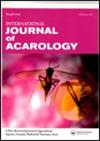Ticks (Parasitiformes: Ixodida: Ixodidae) parasites of wild Baird’s tapirs (Mammalia: Perissodactyla) in the Yucatan Peninsula, Mexico
IF 1
3区 农林科学
Q3 ENTOMOLOGY
引用次数: 0
Abstract
ABSTRACT Tapirs are common hosts of ticks and an individual can be infested by up to seven different tick species. We explored the parasitic tick fauna associated with wild Baird’s tapirs (Tapirus bairdii) from the Yucatan Peninsula. A total of 326 ticks of 10 species of the Family Ixodidae were collected from 15 tapirs. We found a range of one to six tick species per host, but most of the tapirs were parasitized by two or three tick species. We tested the relationship between body condition, sex, and age classes of the tapirs versus the number of tick species on each host. The most common tick species was Amblyomma mixtum found on 93% of the hosts. Amblyomma pecarium, Amblyomma tenellum, Ixodes affinis and Rhipicephalus sanguineus sensu lato were recorded for the first-time parasitizing Baird’s tapirs. We did not find a relationship between body condition, sex, and age classes of tapirs versus the number of parasitizing tick species. Our finding demonstrates that the richness of ticks parasitizing tapirs does not depend on the biological characteristics and health status of the host, but could be determined by other factors such as habitat use and the rate of contact with domestic animals.墨西哥尤卡坦半岛野生贝尔德tapirs(哺乳动物:Perissodactyla)的蜱虫
摘要:Tapirs是蜱虫的常见宿主,一个个体最多可感染七种不同的蜱虫。我们探索了与尤卡坦半岛野生贝尔德貘(Tapirus bairdii)相关的寄生蜱类动物群。从15头貘身上采集到10种硬蜱326只。我们发现每个宿主有一到六种蜱虫,但大多数貘都被两三种蜱虫寄生。我们测试了貘的身体状况、性别和年龄等级与每个宿主上蜱虫物种数量之间的关系。最常见的蜱种是在93%的宿主身上发现的Amblyomma mixtum。记录了首次寄生在贝尔德貘身上的黄曲霉(Amblyomma pecarium)、黄曲霉(Amblyomma tenellum)、亲缘硬蜱(Ixodes affinis)和血红Rhipipcephalus sangeus sensu lato。我们没有发现貘的身体状况、性别和年龄等级与寄生蜱虫物种数量之间的关系。我们的发现表明,寄生在貘身上的蜱虫的丰富度并不取决于宿主的生物学特征和健康状况,而是可能由其他因素决定,如栖息地的使用和与家畜的接触率。
本文章由计算机程序翻译,如有差异,请以英文原文为准。
求助全文
约1分钟内获得全文
求助全文
来源期刊
CiteScore
2.20
自引率
9.10%
发文量
60
审稿时长
6-12 weeks
期刊介绍:
The International Journal of Acarology has a global readership and publishes original research and review papers on a wide variety of acarological subjects including:
• mite and tick behavior
• biochemistry
• biology
• control
• ecology
• evolution
• morphology
• physiology
• systematics
• taxonomy (single species descriptions are discouraged unless accompanied by additional new information on ecology, biology, systematics, etc.)
All submitted manuscripts are subject to initial appraisal by the Editor. If the English is not of a quality suitable for reviewers, the manuscript will be returned. If found suitable for further consideration, it will be submitted to peer review by independent, anonymous expert referees. All peer review is single blind.

 求助内容:
求助内容: 应助结果提醒方式:
应助结果提醒方式:


